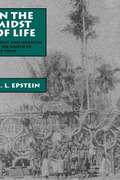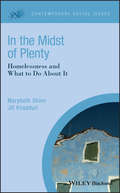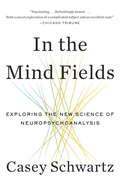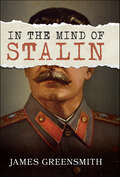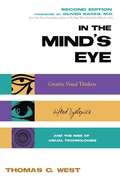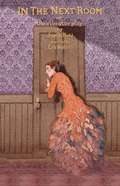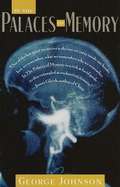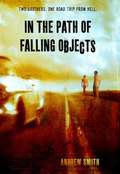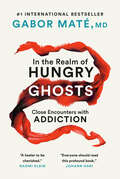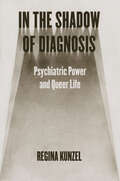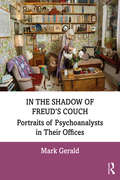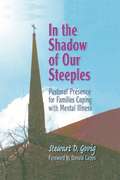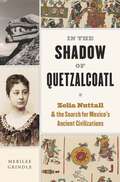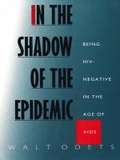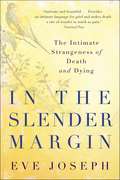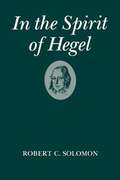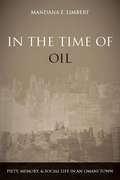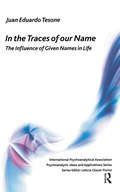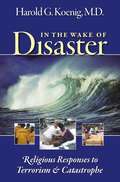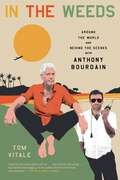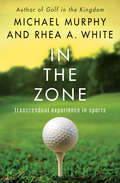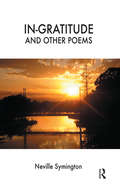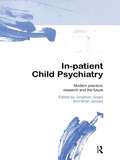- Table View
- List View
In the Midst of Life: Affect and Ideation in the World of the Tolai
by A. L. EpsteinEpstein develops an emotional profile of the Tolai, contending that societies are distinguished as much by the shape of their emotional life as they are by their social arrangements and cultural styles. Epstein describes a wide range of mourning ceremonies and other more and less public occasions.
In the Midst of Plenty: Homelessness and What To Do About It (Contemporary Social Issues #32)
by Marybeth Shinn Jill KhadduriForeword by Nan Roman, President and CEO of the National Alliance to End Homelessness This book explains how to end the U.S. homelessness crisis by bringing together the best scholarship on the subject and sharing solutions that both local communities and national policy-makers can apply now In the Midst of Plenty shifts our understanding of the phenomenon of homelessness away from issues of individual disability and embeds it in larger contexts of poverty, income inequality, housing affordability, and social exclusion. Homelessness experts Shinn and Khadduri provide guidance on how to end homelessness for people who experience it and how to prevent so many people from reaching the point where they have no alternative to sleeping on the street or in emergency shelters. The book is organized around four questions: Who becomes homeless? Why do people become homeless? How do we end homelessness? How do we prevent it? Based on a comprehensive look at relevant research, the authors show that we know how to end homelessness—if we devote the necessary resources to doing so. In the Midst of Plenty: Homelessness and What to Do About It is an excellent resource for professionals and decision-makers in the homeless services system, as well as for anyone who is interested in helping to end homelessness. It also can be used as a text in undergraduate or masters courses in public policy, sociology, psychology, social work, urban studies, or housing policy. “The knowledgeable and thoughtful authors of this book—two brilliant women who know as much as anyone in the country about the nature of homelessness and its solutions—have done a great service by taking us on a journey through the history of homelessness, how our responses have changed, and how we can end it.” Nan Roman, President and CEO National Alliance to End Homelessness. “Shinn and Khadduri’s new book is a thorough yet concise examination of what we know about the nature and causes of homelessness, and the crucial lessons learned. This critically important work provides a roadmap to restoring basic housing and income security as viable policy options, in the face of our daunting inequality divide that otherwise threatens millions with destitution and homelessness.” Dennis Culhane, Dana and Andrew Stone Professor of Social Policy, University of Pennsylvania “Marybeth Shinn and Jill Khadduri have combined their significant expertise to create an essential guide about the history of modern homelessness and to offer a clear path forward to end this American tragedy. Their policy recommendations on ending homelessness are culled from the best about what we know works.” Barbara Poppe, Executive Director US Interagency Council on Homeless, 2009-2014.
In the Mind Fields
by Casey Schwartz"Everywhere I looked it seemed that we were being defined by what our brains were doing . . . Everywhere, there were hucksters and geniuses, all trying to colonize the new world of the brain." "I'd never been a science person," Casey Schwartz declares at the beginning of her far-reaching quest to understand how we define ourselves. Nevertheless, in her early twenties, she was drawn to the possibilities and insights emerging on the frontiers of brain research. Over the next decade she set out to meet the neuroscientists and psychoanalysts engaged with such questions as, How do we perceive the world, make decisions, or remember our childhoods? Are we using the brain? Or the mind? To what extent is it both? Schwartz discovered that neuroscience and psychoanalysis are engaged in a conflict almost as old as the disciplines themselves. Many neuroscientists, if they think about psychoanalysis at all, view it as outdated, arbitrary, and subjective, while many psychoanalysts decry neuroscience as lacking the true texture of human experience. With passion and humor, Schwartz explores the surprising efforts to find common ground. Beginning among the tweedy Freudians of North London and proceeding to laboratories, consulting rooms, and hospital bedsides around the world, Schwartz introduces a cast of pioneering characters, from Mark Solms, a South African neuropsychoanalyst with an expertise in dreams, to David Silvers, a psychoanalyst practicing in New York, to Harry, a man who has lost his use of language in the wake of a stroke but who nevertheless benefits from Silvers's analytic technique. In the Mind Fields is a riveting view of the convictions, obsessions, and struggles of those who dedicate themselves to the effort to understand the mysteries of inner life.From the Hardcover edition.
In the Mind of Stalin
by James GreensmithOn 1 October 1939, Winston Churchill, First Lord of the Admiralty and soon to be the UK’s wartime leader, described Russia as ‘a riddle wrapped in a mystery inside an enigma’. The same can certainly be said of Stalin. How can this paradox of a man, who on the one hand had once exhibited great tenderness and kindness to his daughter Svetlana, and on the other sent millions – including members of his own family - to their deaths, be explained? It is impossible to quantify the total number of deaths attributable to the policies of Stalin, but the ‘Excess Mortality’ (i.e., deaths over and above what would normally have been expected during the period in question) gives an approximate figure in excess of 40 million. However, this is only part of the story of the amount of misery inflicted by the Stalin regime through torture, deliberate starvation, neglect, separation from loved ones, cold and hypothermia (e.g. in the prisons of Siberia), which is unquantifiable and unimaginable. Svetlana confessed that she ‘would never undertake to “explain” what motivated all my father’s actions, simply because I do not possess the psychological genius of [Russian novelist] Dostoevsky, who knew how to “penetrate” into another man’s soul and “examine it from within”’.
In the Mind's Eye: Visual Thinkers, Gifted People with Dyslexia and Other Learning Disabilities, Computer Images and the Ironies of Creativity
by Thomas G. WestExposes myths about conventional intelligence by examining the role of visual-spatial strengths and verbal weaknesses in the lives of 11 gifted individuals, including Albert Einstein and Thomas Edison. Examines research in neuroscience that shows a link between visual talents and verbal difficulties, and discusses developments in computer technology that herald a shift toward the increased use of visual approaches in business and science. This revised edition offers an expanded list of national and international organizations, and an updated bibliography. Annotation c. by Book News, Inc., Portland, Or.
In the Next Room (or the vibrator play)
by Sarah Ruhl"A fascinating, funny and evocative play. . . . Ruhl develops the story with the enticing blend of irreverent humor and skewed realism. . . . It's beautiful." -San Francisco Chronicle"[This] breathtakingly inventive addition to Ruhl's singular body of work . . . has the potential to be a modern masterpiece."-Los Angeles TimesSarah Ruhl made her Broadway debut this fall with her latest effervescent comedy: a play about sex, intimacy, and equality, set in the 1880s, when enthusiasm for the electric light bulb gave rise to a handy new instrument to treat female hysteria. The story revolves around the medical office and home of Dr. Givings, who regularly induces "paroxysm" in his once high-strung patient Sabrina, allowing her to happily return to playing piano. Soon, Sabrina falls in love with the doctor's assistant Annie, and also befriends his wife Catherine, who is dealing with her own neurotic misgivings about not being able to breast-feed her baby. With this new work, Ruhl once again uses playful symbolism and lyrical language as she makes seemingly effortless thematic leaps--crafting a play with tremendous critical and audience appeal, in her singular theatrical voice.Sarah Ruhl's plays include Dead Man's Cell Phone, The Clean House (a Pulitzer Prize finalist), Passion Play, and Eurydice, all of which have been widely produced throughout the United States and internationally. She is a recipient of the MacArthur Fellowship.
In the Palaces of Memory: How We Build the Worlds Inside Our Heads
by George JohnsonEven as you read these words, a tiny portion of your brain is physically changing. New connections are being sprouted--a circuit that will create a jab of recognition if you encounter the words again. That is one of the theories of memory presented in this intriguing and splendidly readable book, which distills three researchers' inquiries into the processes that enable us to recognize a face that has aged ten years or remember a melody for decades.
In the Path of Falling Objects
by Andrew SmithJonah and his younger brother, Simon, are on their own. They set out to find what is left of their family, carrying between them ten dollars, a backpack full of dirty clothes, a notebook, and a stack of letters from their brother, who is serving a tour in Vietnam. And soon into their journey, they have a ride. With a man and a beautiful girl who may be in love with Jonah. Or Simon. Or both of them. The man is crazy. The girl is desperate. This violent ride is only just beginning. And it will leave the brothers taking cover from hard truths about loyalty, love, and survival that crash into their lives. One more thing: The brothers have a gun. They're going to need it.
In the Realm of Hungry Ghosts: Close Encounters with Addiction
by Gabor MateIn this timely and profoundly original new book, bestselling writer and physician Gabor Maté looks at the epidemic of addictions in our society, tells us why we are so prone to them and what is needed to liberate ourselves from their hold on our emotions and behaviours.For over seven years Gabor Maté has been the staff physician at the Portland Hotel, a residence and harm reduction facility in Vancouver’s Downtown Eastside. His patients are challenged by life-threatening drug addictions, mental illness, Hepatitis C or HIV and, in many cases, all four. But if Dr. Maté’s patients are at the far end of the spectrum, there are many others among us who are also struggling with addictions. Drugs, alcohol, tobacco, work, food, sex, gambling and excessive inappropriate spending: what is amiss with our lives that we seek such self-destructive ways to comfort ourselves? And why is it so difficult to stop these habits, even as they threaten our health, jeopardize our relationships and corrode our lives?Beginning with a dramatically close view of his drug addicted patients, Dr. Maté looks at his own history of compulsive behaviour. He weaves the stories of real people who have struggled with addiction with the latest research on addiction and the brain. Providing a bold synthesis of clinical experience, insight and cutting edge scientific findings, Dr. Maté sheds light on this most puzzling of human frailties. He proposes a compassionate approach to helping drug addicts and, for the many behaviour addicts among us, to addressing the void addiction is meant to fill.I believe there is one addiction process, whether it manifests in the lethal substance dependencies of my Downtown Eastside patients, the frantic self-soothing of overeaters or shopaholics, the obsessions of gamblers, sexaholics and compulsive internet users, or in the socially acceptable and even admired behaviours of the workaholic. Drug addicts are often dismissed and discounted as unworthy of empathy and respect. In telling their stories my intent is to help their voices to be heard and to shed light on the origins and nature of their ill-fated struggle to overcome suffering through substance use. Both in their flaws and their virtues they share much in common with the society that ostracizes them. If they have chosen a path to nowhere, they still have much to teach the rest of us. In the dark mirror of their lives we can trace outlines of our own.—from In the Realm of Hungry Ghosts
In the Shadow of Diagnosis: Psychiatric Power and Queer Life
by Regina KunzelA look at the history of psychiatry’s foundational impact on the lives of queer and gender-variant people. In the mid-twentieth century, American psychiatrists proclaimed homosexuality a mental disorder, one that was treatable and amenable to cure. Drawing on a collection of previously unexamined case files from St. Elizabeths Hospital, In the Shadow of Diagnosis explores the encounter between psychiatry and queer and gender-variant people in the mid- to late-twentieth-century United States. It examines psychiatrists’ investments in understanding homosexuality as a dire psychiatric condition, a judgment that garnered them tremendous power and authority at a time that historians have characterized as psychiatry’s “golden age.” That stigmatizing diagnosis made a deep and lasting impact, too, on queer people, shaping gay life and politics in indelible ways. In the Shadow of Diagnosis helps us understand the adhesive and ongoing connection between queerness and sickness.
In the Shadow of Freud’s Couch: Portraits of Psychoanalysts in Their Offices
by Mark GeraldIn the Shadow of Freud’s Couch: Portraits of Psychoanalysts in Their Offices uses text and images to form a complex portrait of psychoanalysis today. It is the culmination of the authors 15-year project of photographing psychoanalysts in their offices across 27 cities and ten countries. Part memoir, part history, part case study, and part self-analysis, these pages showcase a diversity of analysts: male and female and old-school and contemporary. Starting with Freud’s iconic office, the book explores how the growing diversity in both analysts and patient groups, and changes in schools of thought have been reflected in these intimate spaces, and how the choices analysts make in their office arrangements can have real effects on treatment. Along with the presentation of images, Mark Gerald explores the powerful relational foundations of theory and clinical technique, the mutually vulnerable patient-analyst connection, and the history of the psychoanalytic office. This book will be of great interest to psychoanalysts and psychoanalytic psychotherapists, as well as psychotherapists, counsellors, and social workers interested in understanding and innovating the spaces used for mental health treatment. It will also appeal to interior designers, office architects, photographers, and anyone who ever considered entering a psychoanalyst's office.
In the Shadow of Illness
by Myra Bluebond-LangnerWhat is it like to live with a child who has a chronic, life-threatening disease? What impact does the illness have on well siblings in the family? The author suggests that understanding the impact of the illness lies not in the identifying deficiencies in the lives of those affected, but in appreciating how family members carry on with their lives in the face of the disease's intrusion. She looks at how parents adjust their priorities and their idea of what constitutes a normal life, how they try to balance the needs of other family members while caring for the ill child, and how they see the future. Since the issues raised are not unique to cystic fibrosis but are common to other chronic and life-threatening illnesses, this book will be of interst to all who study, care for, or live with the seriously ill.
In the Shadow of Our Steeples: Pastoral Presence for Families Coping with Mental Illness
by Stewart D. Govig *Deceased*In the Shadow of Our Steeples: Pastoral Presence for Families Coping with Mental Illness helps you and other experts and quasi-experts in the field of religious and family counseling to give sound direction and guidance to family members who are caring for a loved one who suffers from mental illness. You'll find many avenues of care and counseling that will greatly enhance your ability to lend support and encouragement in situations where the burden of care seems too great for only a few individuals to lift. In reading it, you'll find your options increase tenfold, and you'll become a better symbol and resource of faith for these unique families.Inside In the Shadow of Our Steeples, you'll discover how to cure the obsession with success that too often goes along with counseling situations that involve mental illness. You'll also discover a greater, more enduring strain of Christian love, full of surprising joys, caring, and hope. Geared toward moving parishes away from public stigmas and toward a collective ministry of presence, this book beckons to those clergy who know and believe that a far more understanding and far-reaching form of counseling exists. Specifically, you'll learn about these and other long-sought-after aids: establishing theological foundations and goal-setting in the area of pastoral care countering the stigmas of mental illness using biblical studies and models using a “ministry of presence” to analyze chronic illness and promote “rehabilitation in the absence of cure” bringing clergy and mental health professionals into a collaborative arena of care improving the relationship of professional chaplains to clergy in ordinary parish settingsOverall, In the Shadow of Our Steeples helps bring together the sufferer, the family, the civil servant, and the religious counselor into one synergistic group of rehabilitative influence. This sound guide's specific examples and proven strategies will help turn your despair into hope, even in the face of chronic mental illness.
In the Shadow of Quetzalcoatl: Zelia Nuttall and the Search for Mexico’s Ancient Civilizations
by Merilee Grindle"What a woman! And what a fabulous life to unearth. Zelia Nuttall was incredibly smart, determined, a divorced single mother in a man’s world, a great scholar, and an original thinker—yet today she’s completely forgotten. Merilee Grindle has dug deep into the archives and uncovered her fascinating story."—Andrea Wulf, author of The Invention of Nature"Zelia Nuttall comes alive in all her fascinating contradictions in Merilee Grindle’s capable hands...[This] biography challenges our modern smugness and reminds us that our roots as scholars are more complex than we often acknowledge."—Camilla Townsend, author of Fifth Sun: A New History of the AztecsThe gripping story of a pioneering anthropologist whose exploration of Aztec cosmology, rediscovery of ancient texts, and passion for collecting helped shape our understanding of pre-Columbian Mexico.Where do human societies come from? The drive to answer this question took on a new urgency in the nineteenth century, when a generation of archaeologists began to look beyond the bible for the origins of different cultures and civilizations. A child of the San Francisco Gold Rush whose mother was born in Mexico City, Zelia Nuttall threw herself into the study of Aztec customs and cosmology, eager to use the tools of the emerging science of anthropology to prove that modern Mexico was built over the ruins of ancient civilizations.Proud, disciplined, as prickly as she was independent, Zelia Nuttall was the first person to accurately decode the Aztec calendar stone. An intrepid researcher, she found pre-Columbian texts lost in European archives and was skilled at making sense of their pictographic histories. Her work on the terra-cotta heads of Teotihuacán captured the attention of Frederic Putnam, who offered her a job at Harvard’s Peabody Museum.Divorced and juggling motherhood and career, Nuttall chose to follow her own star, publishing her discoveries and collecting artifacts for US museums to make ends meet. From her beloved Casa Alvarado in Coyoacán, she became a vital bridge between Mexican and US anthropologists, connecting them against the backdrop of war and revolution.The first biography of Zelia Nuttall, In the Shadow of Quetzalcoatl captures the appeal and contradictions that riddled the life of this trailblazing woman, who contributed so much to the new field of anthropology until a newly professionalized generation overshadowed her remarkable achievements and she became, in the end, an artifact in her own museum.
In the Shadow of the Epidemic: Being HIV-Negative in the Age of AIDS
by Walt OdetsFor gay men who are HIV-negative in a community devastated by AIDS, survival may be a matter of grief, guilt, anxiety, and isolation. In the Shadow of the Epidemic is a passionate and intimate look at the emotional and psychological impact of AIDS on the lives of the survivors of the epidemic, those who must face on a regular basis the death of friends and, in some cases, the decimation of their communities. Drawing upon his own experience as a clinical psychologist and a decade-long involvement with AIDS/HIV issues, Walt Odets explores the largely unrecognized matters of denial, depression, and identity that mark the experience of uninfected gay men.Odets calls attention to the dire need to address issues that are affecting HIV-negative individuals--from concerns about sexuality and relations with those who are HIV-positive to universal questions about the nature and meaning of survival in the midst of disease. He argues that such action, while explicitly not directing attention away from the needs of those with AIDS, is essential to the human and biological well-being of gay communities. In the immensely powerful firsthand words of gay men living in a semiprivate holocaust, the need for a broader, compassionate approach to all of the AIDS epidemic's victims becomes clear. In the Shadow of the Epidemic is a pathbreaking first step toward meeting that need.
In the Slender Margin: The Intimate Strangeness of Death and Dying
by Eve JosephLike Joan Didion's The Year of Magical Thinking, an extraordinarily moving and engaging look at loss and death. Eve Joseph is an award-winning poet who worked for twenty years as a palliative care counselor in a hospice. When she was a young girl, she lost a much older brother, and her experience as a grown woman helping others face death, dying, and grief opens the path for her to recollect and understand his loss in a way she could not as a child. In the Slender Margin is an insider's look at an experience that awaits us all, and that is at once deeply fascinating, frightening, and in modern society shunned. The book is an intimate invitation to consider death and our response to it without fear or morbidity, but rather with wonder and a curious mind. Writing with a poet's precise language and in short meditative chapters leavened with insight, warmth, and occasional humor, Joseph cites her hospice experience as well as the writings of others across generations—from the realms of mythology, psychology, science, religion, history, and literature—to illuminate the many facets of dying and death. Offering examples from cultural traditions, practices, and beliefs from around the world, her book is at once an exploration of the unknowable and a very humane journey through the land of grief.
In the Spirit of Hegel: A Study of G.W.F. Hegel's Phenomenology of Spirit
by Robert C. SolomonIn this book, the author captures the bold and exhilarating spirit, presenting the Phenomenology as a thoroughly personal as well as philosophical work. He begins with a historical introduction, which lays the groundwork for a section-by-section analysis of the Phenomenology. Both the initiated and readers unacquainted with the intricacies of German idealism will find this to be an accessible and exciting introduction to this philosopher's monumental work.
In the Time of Oil
by Mandana E. LimbertBefore the discovery of oil in the late 1960s, Oman was one of the poorest countries in the world, with only six kilometers of paved roads and one hospital. By the late 1970s, all that had changed as Oman used its new oil wealth to build a modern infrastructure. In the Time of Oil describes how people in Bahla, an oasis town in the interior of Oman, experienced this dramatic transformation following the discovery of oil, and how they now grapple with the prospect of this resource's future depletion. Focusing on shifting structures of governance and new forms of sociality as well as on the changes brought by mass schooling, piped water, and the fracturing of close ties with East Africa, Mandana Limbert shows how personal memories and local histories produce divergent notions about proper social conduct, piety, and gendered religiosity. With close attention to the subtleties of everyday life and the details of archival documents, poetry, and local histories, Limbert provides a rich historical ethnography of oil development, piety, and social life on the Arabian Peninsula.
In the Traces of our Name: The Influence of Given Names in Life (The International Psychoanalytical Association Psychoanalytic Ideas and Applications Series)
by Juan Eduardo TesoneThis book emphasizes the influence of the name given at birth in terms of the construction of subjectivity. It offers the reader a fascinating journey through the meanders of culture, literary quotations, stories heard, and a difficult journey through the pain and horror of certain realities.
In the Wake of Disaster: Religious Responses to Terrorism and Catastrophe
by Harold G. KoenigIn a timely book with a powerful and persuasive message, Dr. Harold G. Koenig addresses federal, state, and local government policy leaders, urging them to more fully integrate religious organizations into the formal disaster response system, and he then provides recommendations on how this can effectively be done. Koenig also advocates faith communities and organizations to learn more about the role they can play in responding to disasters and terrorism. The chaotic aftermath of Hurricane Katrina made extraordinarily clear the gaps in the United States' disaster policies. At the same time, the contributions of organized faith communities were highlights amidst the bungled federal, state, and local responses. One example is the New York Times, September 9, 2005, headline: "A New Meaning for 'Organized Religion': It Helps the Needy Quickly. " But as faith-based organizations look for ways to help, there are few, if any, guidelines for them. This book provides information on the psychological, social, and spiritual responses to trauma. It addresses how the emergency response system works, and the role that religious communities can play in disaster response and recovery in terms of providing emotional and spiritual care for victims. It advocates integrating mental health into emergency response systems directed at those affected by hurricanes, floods, earthquakes, and terrorism. "The aim is to help victims of disaster to better cope with the stresses they face, as well as help direct care workers (firefighters, police, health care providers, etc. ) to deal better emotionally with the trauma to which they are exposed so they can remain effective and functional on the job," explains Dr. Koenig, whose research on the healing power of faith has been published worldwide. Increasing the resiliency of our communities in the face of disaster is crucial. Religious communities have tremendous potential to contribute to this. Here are guidelines on how to do that more effectively, alongside data on how to facilitate the integration of these contributions with the formal disaster-response system.
In the Weeds: Around the World and Behind the Scenes with Anthony Bourdain
by Tom VitaleAnthony Bourdain's long time director and producer takes readers behind the scenes to reveal the insanity of filming television in some of the most volatile places in the world and what it was like to work with a legend. In the nearly two years since Anthony Bourdain's death, no one else has come close to filling the void he left. His passion for and genuine curiosity about the people and cultures he visited made the world feel smaller and more connected. Despite his affable, confident, and trademark snarky TV persona, the real Tony was intensely private, deeply conflicted about his fame, and an enigma even to those close to him. Tony&’s devoted crew knew him best, and no one else had a front-row seat for as long as his director and producer, Tom Vitale.Over the course of more than a decade traveling together, Tony became a boss, a friend, a hero and, sometimes, a tormentor.In the Weeds takes readers behind the scenes to reveal not just the insanity that went into filming in some of the most far-flung and volatile parts of the world, but what Tony was like unedited and off-camera. From the outside, the job looked like an all-expenses-paid adventure to places like Borneo, Vietnam, Iran, the Democratic Republic of Congo, and Libya. What happened off-camera was far more interesting than what made it to air. The more things went wrong, the better it was for the show. Fortunately, everything fell apart constantly.
In the Zone: Transcendent Experience in Sports
by Michael Murphy Rhea A. WhiteMichael Murphy, bestselling author of Golf in the Kingdom, explains the power of athletics to transform the body, mind, and spirit Athletes and coaches often say they feel &“in the zone&” while participating in sports or other endeavors, and Esalen Institute cofounder Michael Murphy carefully documents this phenomenon in one of the most comprehensive works of its kind. Murphy and coauthor Rhea A. White categorize twenty types of extraordinary athletic feats, exalted states of consciousness, and altered perceptions that, they say, evoke the richness of a spiritual practice. This wide-ranging compendium includes insights from amateur, Olympic, and professional athletes, such as Michael Jordan, Mario Andretti, Jack Nicklaus, and Arnold Schwarzenegger.
In-Class Activities Manual for Instructors of Introductory Psychology
by Patricia A. Jarvis Cynthia R. Nordstrom Karen B. WilliamsNIMAC-sourced textbook
In-gratitude and Other Poems
by Neville Symington'Where does the creative act come from? No one knows. All the rash of literature in recent times from artists, scientists and theologians on the subject of consciousness finds its origin in this puzzle.Creating what has happened to one into an art form has one effect: it dissolves the barrier between the present and the past. The past is constantly stimulated into life by present experiencesparticularly when listening to someone else relating their experiences. It brings me then into a close sharing of experience with the other. Analytic theories are substitutes for these personal experiences.So these poems are a few casual glimpses when the spirit has risen to the challenge. They are not a big offering but they mean a lot to me. The most important of these is the long poem IN-GRATITUDE which comes first.
In-patient Child Psychiatry: Modern Practice, Research and the Future
by Jonathan Green Brian JacobsEssential Reading for clinicians, managers and researchers in child psychiatry, this authoritative book provides accessible coverage of essential theory as well as clear practical guidance to inpatient child psychiatric treatment. This method of treatment has fallen out of fashion in recent years in favour of community-based care, but remains a useful setting for treating more seriously ill patients. Bringing together contributions from across the profession, this book covers the 'state-of-the-art' in current clinical treatment, and sets a bold new agenda for the future, arguing that inpatient child psychiatric units retain great potential for creative, effective, relevant treatment.
